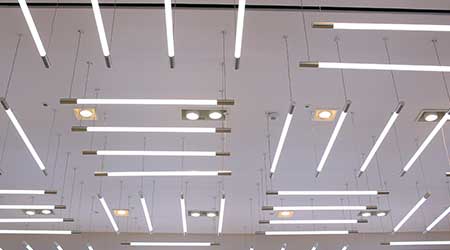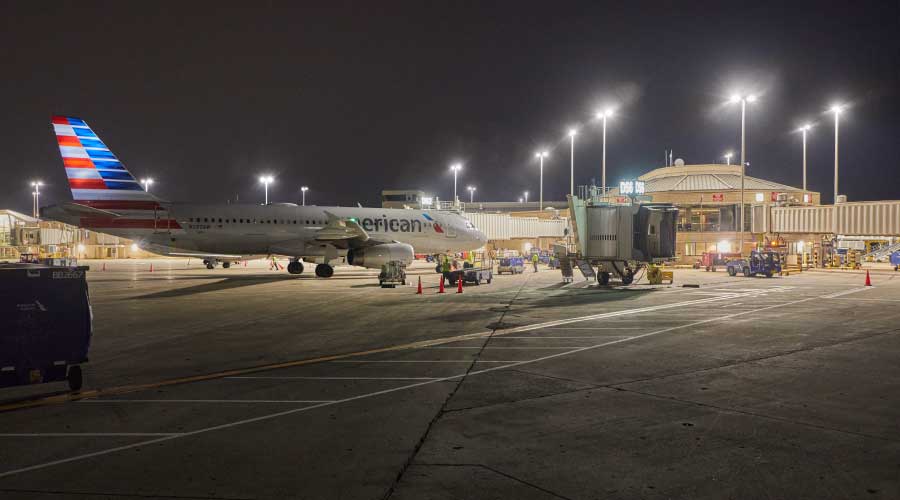Understand The ABCs of LED Retrofit Kits
Converting to tubular LEDs (TLEDs) could be super advantageous for facility managers. Here's what you need to know about TLEDs classifications.
The benefits of LEDs are leading many facility managers to convert linear fluorescent fixtures (e.g., 2x4 troffers) to use LED lighting technologies or to consider doing so. The two options are tubular LEDs (TLEDs) and LED retrofit kits. (A third option is to replace the entire fixture.) Here’s a look at key points to consider and changes in technology in both TLEDs and LED retrofit kits.
First, though, remember to always carefully read spec sheets and test the option in a mock-up before you invest. In some cases LEDs are being paired with lighting control options such as dimming and occupancy sensing. To maximize the benefits of LEDs, consider how your facility’s lighting should look for the next 10 to 20 years, which is how long it may be before LED units bought now begin to wear out. If you focus only on achieving quick savings you could miss valuable longer term opportunities. (For more on how to choose the right LEDs for a retrofit, see this Building Operating Management story.)
Type A TLEDs: Simplest option
UL has three classifications for TLEDs: Types A, B, and C. Type A uses existing ballasts, making ballast compatibility an issue. Types B and C bypass ballasts but alter a fixture’s internal wiring. Unlike Types B and C, UL sees Type A TLEDs as merely a different form of lamp, with appropriately relaxed rules.
For their Type A TLEDs, manufacturers list compatible ballasts. Even where all are electronic, some Type A units work only with instant (not rapid or programmed) start ballasts, while others work with all starting modes. Only one was found that also works with magnetic ballasts, as noted below. Many facilities, however, have a mix of electronic ballasts (and no record of the type in each fixture). In such situations, look for Type A TLEDs compatible with all starting modes.
Other ballast issues deserve attention. If in service for over 15 to 20 years, some may be getting ready to fail. Lighting contractors, not wanting to deal with callbacks after a TLED conversion, may avoid Type A units because of that liability. No TLED should be installed in old fixtures using pre-heat ballasts or transformers. Unless a TLED’s spec sheet says so, the same is true for fixtures using dimming ballasts, or those equipped with internal backup batteries that may step-dim lamps during a power outage.
An exception is TLEDs offered by ELB Electronics, which are guaranteed to work with any electronic or magnetic ballast. ELB offers a $2,500 bounty to any customer that provides a ballast with which its units won’t work. Like all wonderful technologies, that latitude comes at a price.
If dimming is desired, Revolution Lighting offers a Type A TLED containing internal circuitry that dims while powered by a non-dimming electronic ballast, via signals sent by manipulating a standard on-off light switch. Some varieties of Types B and C offer drivers that will work with dimmers.
Different starting modes may also make existing lampholders (also called sockets or “tombstones”) an issue. Those used with instant start ballasts are shunted, meaning that a wire bridge exists within the lampholder that sends power from a single wire to both socket contacts. A potential problem may occur when installing a TLED designed to work only with unshunted lampholders (e.g., rapid start ballasts). Before purchasing or testing, check spec sheets for lampholder issues. Learn more about socket shunting at: https://blog.1000bulbs.com/home/shunted-vs-non-shunted-lampholders.
Lampholder condition may also be an issue. Those in old fixtures may be cracked or loose, and should be replaced when installing TLEDs. Facilities in earthquake-prone areas should note whether existing lampholders will secure the extra weight of a proposed TLED (ranging from a few ounces to almost half a pound) during vibration.
Type B TLEDs:
No ballast issues, but…
Like UL Type A units, UL Type B TLEDs also have their own internal LED drivers, but run on line voltage power rather than the stepped-down voltage from fluorescent ballasts. Existing ballasts are bypassed, so compatibility (an issue with Type A) is not a concern. Ballasts may be removed or left in place. Line voltage wiring previously going to the ballast is re-routed directly to the lampholders, which are rated for 600 volts. Some jurisdictions require that a licensed electrician perform such work. The condition of the existing lampholders may be an issue: If cracked or loose, replacement may be necessary.
For years, concerns were raised over how rewiring might violate fixture UL Listings, which could impact both safety and fire insurance liabilities. Many utilities refused to offer rebates for Type B units. In July 2017, Tom Lichtenstein of UL clarified the matter by stating that: “These kits [retrofits or Type B TLEDs] are certified for retrofitting an existing Listed luminaire in the field. When you modify an existing UL Listed luminaire after it leaves the factory, the only way to determine if the modified luminaire continues to meet UL’s requirements is to use a certified retrofit kit appropriate for the luminaire or a UL Field Evaluation would be necessary.” In other words, if the Type B TLED has a UL label (found on its spec sheet), the UL of the fixture in which it is installed according to the TLED’s instructions is not violated. With this understanding, some utilities previously not rebating Type B units now do so.
To avoid any safety issues if an attempt is later made to install a fluorescent lamp in a converted fixture, UL requires that labels accompanying Type B TLEDs be affixed to those fixtures, warning custodians not to do so. That label should also indicate if the fixture has been re-wired to use TLEDs that take power from only one or both of its ends. To minimize lamp and labor costs, some Type B units are designed to take power from only one of their ends. In the future, installing a different brand of Type B TLED could cause problems.
Are Type C units the tops?
Type C TLEDs also bypass existing ballasts, but (unlike Types A and B) their drivers are external to their lamps. Installation of the new driver may require removal of the fixture’s ballast. Low-voltage wiring runs from the driver to the lampholders, avoiding the Type B line voltage issue, though the condition of existing lampholders may still be an issue. Due to rewiring of the fixture, adherence to the same UL requirements as Type B units (e.g., UL labeling of the unit, proper installation, adding warning labels) is essential. Installation may involve a bit more labor, and may require use of a licensed electrician. Relative to their Type A and B cousins, however, Type C units may offer additional perks:
• Efficacy may be higher (some Type B suppliers claim comparable or higher lumens per watt).
• Drivers may be replaceable, thus stretching the useful life of the TLED.
• Without internal drivers, Type C lamps may weigh less, eliminating an issue in some locales.
• Drivers may be available that accept existing 0-10 volt dimmer control wiring. Compatibility with existing or proposed dimmers (e.g., no flickering at any setting) should be verified via field testing before bulk purchasing.
Note that, unlike fluorescent ballasts which will power any appropriate fluorescent lamp, external LED drivers are not yet standardized. Should a driver replacement be needed, it will likely need to be obtained from the manufacturer of the installed Type C TLED.
Related Topics:














